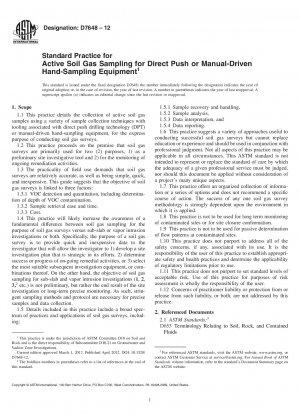ASTM D7648-12
Standard Practice for Active Soil Gas Sampling for Direct Push or Manual-Driven Hand-Sampling Equipment
- Standard No.
- ASTM D7648-12
- Release Date
- 2012
- Published By
- American Society for Testing and Materials (ASTM)
- Status
- Replace By
- ASTM D7648/D7648M-18
- Latest
- ASTM D7648/D7648M-18
- Scope
Soil gas is simply the gas phase (air) that exists in the open spaces between soil particles in the unsaturated portion of the vadose zone. Normally comprised of nitrogen and oxygen, soil gas becomes contaminated when volatile organic compounds (VOCs) are released in the subsurface due to spills or leaks, and they begin to evaporate from a fluid phase and become part of the soil gas. Over time, VOCs can potentially migrate through the soil or groundwater or both and present a problem to the environment and human health.
Application of Soil Gas Surveys8212;Soil gas surveying offers an effective, quick and cost-effective method of detecting volatile contaminants in the vadose zone. Soil gas surveying has been demonstrated to be effective for selection of suitable and representative samples for other more costly and definitive investigative methods. This method is highly useful at the initiation of an investigation into the preliminary site investigation of determining the existence and extent of volatile or semivolatile organic contamination, and determination of location of highest concetrations, as well as, monitoring the effectiveness of on-going remedial activities.
Samples are collected by inserting a sampling device into a borehole with hydraulically-driven direct push drilling technology or manually-driven driven hand sampling equipment.
Soil gas surveys can be performed over a wide range of spatial designs. Spatial designs include soil gas sampling in profiles or grid patterns at a single depth or multiple depths. Multiple depth sampling is particularly useful for contaminant determinations in cases with complex soil type distribution and multiple sources. Depth profiling can also be useful in the determination of the most appropriate depth(s) at which to monitor soil gas, as well as the demonstration of migration and degradation processes in the vadose zone.
Soil gas surveys are used extensively in preliminary site investigations and monitoring of effectiveness of on-going site remediation efforts. Project objectives must be known and the limitation of this method considered. Limitations include:
Data generated from soil gas surveying is relative and not of the quality necessary for a single data set; and
Soil gas surveys need to be done quickly, so this method is for active soil-gas sampling devices only.
1.1 This practice details the collection of active soil gas samples using a variety of sample collection techniques with tooling associated with direct push drilling technology (DPT) or manual-driven hand-sampling equipment, for the express purpose of conducting soil gas surveys.
1.2 This practice proceeds on the premise that soil gas surveys are primarily used for two (2) purposes, 1) as a preliminary site investigative tool and 2) for the monitoring of ongoing remediation activities.
1.3 The practicality of field use demands that soil gas surveys are relatively accurate, as well as being simple, quick, and inexpensive. This guide suggests that the objective of soil gas surveys is linked to three factors:
1.3.1 VOC detection and quantitation, including determination of depth of VOC contamination.
1.3.2 Sample retrieval ease and time.
1.3.3 Cost.
1.4 This practice will likely increase the awareness of a fundamental difference between soil gas sampling for the purpose of soil gas surveys versus sub-slab or vapor intrusion investigations or both. Specifically, the purpose of a soil gas survey is to provide quick and inexpensive data to the investigator that will allow the investigator to 1) develop a site investigation plan that is strategic in its efforts, 2) determine success or progress of on-going remedial activities, or 3) select the most suitable subsequent investigation equi......
ASTM D7648-12 Referenced Document
- ASTM D1356 Standard Terminology Relating to Sampling and Analysis of Atmospheres*, 2024-04-19 Update
- ASTM D1357 Standard Practice for Planning the Sampling of the Ambient Atmosphere
- ASTM D1452 Standard Practice for Soil Investigation and Sampling by Auger Borings
- ASTM D3249 Standard Practice for General Ambient Air Analyzer Procedures
- ASTM D3614 Standard Guide for Laboratories Engaged in Sampling and Analysis of Atmospheres and Emissions
- ASTM D5314 Standard Guide for Soil Gas Monitoring in the Vadose Zone
- ASTM D6196 Standard Practice for Selection of Sorbents and Pumped Sampling/Thermal Desorption Analysis Procedures for Volatile Organic Compunds in Air
- ASTM D653 Standard Terminology Relating to Soil, Rock, and Contained Fluids
ASTM D7648-12 history
- 2018 ASTM D7648/D7648M-18 Standard Practice for Active Soil Gas Sampling for Direct Push or Manual-Driven Hand-Sampling Equipment
- 2012 ASTM D7648-12 Standard Practice for Active Soil Gas Sampling for Direct Push or Manual-Driven Hand-Sampling Equipment
